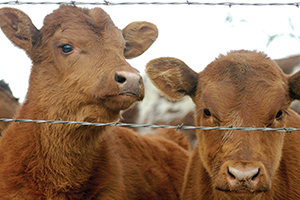Meat industry on board with new FDA restrictions
Catholic Health Initiatives has joined eight other major hospital groups in a campaign to reduce the medically unnecessary use of veterinary antibiotics in producing the nation's meat and poultry supplies.
"We believe that what we eat is a significant component of health care," said Dave Ryan, who oversees CHI food and nutrition services for its far-flung hospital network. "We want to help push the meat industry to provide a healthier food supply and do so economically."

Catholic Health Initiatives is among health systems working in conjunction with Health Care Without Harm to limit antibiotic treatment in animals raised for meat to medically important uses. © Dizajune
CHI and the other health systems are working on the effort with Health Care Without Harm, which promotes environmentally safer practices by health providers. Through the effort launched in August, Health Care Without Harm seeks to employ the market heft of health care providers to eliminate what it calls the overuse of antibiotics in raising the nation's meat-producing animals. The advocacy group says the nine participating health systems, including CHI, spend about $34 million annually on meat and poultry.
The issue parallels the national effort to reduce antibiotic use in people and animals. Although animals and people usually don't get the same infections, the well-documented dangers of drug-resistant mutations in bacteria apply to all species, which increases the risk of drug-resistant strains spreading from animal herds and flocks to humans, according to Health Care Without Harm.
"We absolutely need to transform the way we raise animals," said Stacia Clinton, national director of healthy food for the health advocacy group in Reston, Va. "One of the most pressing problems is the overuse of antibiotics in animal agriculture."
Big appetite
The United States annually consumes more than 30 million cattle, 100 million hogs, 200 million turkeys and 8 billion — yes, billion — chickens, according to the North American Meat Institute. For its part, CHI buys about 4 million pounds of meat and poultry each year for its hospitals and other health care facilities.

Ryan
About half of CHI's volume is ground beef. Roughly one-third of the food it prepares goes to patients, and the rest is provided to employees and visitors.
Ryan said participation in this national campaign follows CHI's long-standing mission of promoting healthy communities.
He said CHI is not trying to keep all antibiotics out of meat production, but to limit it to medically necessary care of animals and to finally stop the routine application to promote animal growth.
The issues aren't new — in 2012, the U.S. Food and Drug Administration advised producers to avoid using antibiotics to create bigger animals, a result of killing intestinal bacteria to free more protein for muscle growth.
FDA restrictions
Significant new federal rules went into effect on Jan. 1 requiring prescriptions or veterinary feed directives from veterinarians for most uses of "medically important antimicrobials" and prohibiting their use to induce weight gain in feed animals.
Drug companies have agreed to remove from the labels of animal antibiotics that the products can be used to promote growth, said Eric Mittenthal, a spokesman for the Meat Institute. The new FDA rule also requires animal-raising operations to limit use of antibiotics to their stated purposes.
Mittenthal's organization represents such giants as Tyson Foods, Cargill and Hormel Foods, which process and sell meat to retail and commercial customers. While it doesn't directly represent farmers or ranchers, its companies have a major impact upon producers.
"The judicious use of antibiotics is very much accepted by the industry, which is headed in that direction if not already there," Mittenthal said. "There's not a major difference in what the hospitals and the industry are trying to do. The industry is very committed to following FDA guidance."
Mittenthal said people need to remember that animals get sick too, and need antibiotics to cure illness. He also said the larger chickens that shoppers find in their supermarkets are mainly the result of breeding, not antibiotics.
Prophylactic use
Clinton, of Health Care Without Harm, said the organization wants to limit the use of antibiotics to treating sick animals, not for routine prevention. She said ranchers and farmers often use antibiotics to keep animals from getting sick. According to an FDA fact sheet, that agency's position on prophylactic antibiotics is that "it is important such use is appropriately targeted to animals at risk for a specific disease and the use and duration is limited and risk-based."
"Large-scale animal operations tend to breed infections, so there is the application (of antibiotics) in feed and water supplies," said Clinton, who formerly worked in food-service management for Boston-area hospitals. "It gets in the soil, in the dust when animals are moved, in the waterways. It increases the risk for creating superbugs."
About 23,000 Americans die each year of infections caused by drug-resistant bacteria, according to the Centers for Disease Control and Prevention.
The new FDA rules on animal antibiotics still will allow veterinarians to prescribe application by feed or water, which Health Care Without Harm opposes. Mittenthal, of the Meat Institute, said that kind of approved application would meet its definition of "medically important," which puts the health care group and meat institute at odds on that point.
Clinton said Health Care Without Harm also seeks more transparency in food labeling and reporting, which are governed by the U.S. Department of Agriculture. She said buyers, especially large ones such as hospital groups, will need to press their suppliers for more information on meat production.
Clinton said hospitals may want to seek bids from multiple suppliers, including smaller local ones, rather than following the tradition of large single contracts. It will take time for producers to catch up with demand, she said.
Copyright © 2017 by the Catholic Health Association
of the United States
For reprint permission, contact Betty Crosby or call (314) 253-3490.